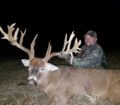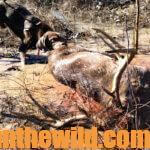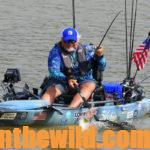Editor’s Note: To take an extraordinary buck with the characteristics of a legend, most veteran hunters start their research not in the woods but on the front porches of clubhouses or around the potbellied stoves of the local general stores, close to where the legend roams. These hunters also use trail cameras and study the times and places where extraordinary bucks appear.
By interviewing the outdoorsmen who have hunted the legend, the experienced hunter gathers much needed information. The interviews will reveal where the buck goes, how he acts, where he’s been shot at, where he likes to bed, what he looks like, which tactics have been tried, what the legend does before, during and after the rut and 101 other characteristics. From listening to all the stories about an extraordinary buck, the veteran hunter can begin to understand the deer’s personality. He also will know what techniques will not or have not worked. He will learn the region where the animal has had a lead or a broadhead encounter and isn’t likely to show up again. He will begin to understand as much about the men who hunt the legend as the animal knows about them.
 Utilizing all his experience from years of hunting, the veteran now will begin to discard tactics and areas to hunt that he feels won’t allow him a shot at the legend. Most novice legend hunters fail because they don’t get the facts before entering the woods. One or two days spent gathering information from other hunters can save weeks or years of unsuccessful hunting.
Utilizing all his experience from years of hunting, the veteran now will begin to discard tactics and areas to hunt that he feels won’t allow him a shot at the legend. Most novice legend hunters fail because they don’t get the facts before entering the woods. One or two days spent gathering information from other hunters can save weeks or years of unsuccessful hunting.
Going in After an Extraordinary Buck:
One of the tactics that has produced extraordinary bucks is what I call going in after the buck. Since a trophy buck only will travel in thick cover during daylight hours, most of his moving time may be just at dawn and at dusk. Once you know the thick cover a legend uses to travel through to get to food, water or his bed, then you have a chance to bag your trophy. However, a common mistake made by novice legend hunters is to sit on the edge of cover and hope to take a quick shot as the buck enters or leaves the thick places. Since a trophy buck understands he’s the most vulnerable on the edge of the thicket, all of his senses will be keenly tuned. He will look, smell and listen for danger. He will spend a lot of time hunting the hunter. If the deer finds the hunter, he may retreat back into the thicket or choose another route out. If he doesn’t sense the hunter, he often still will move quickly and quietly and use whatever cover remains to cross a sparsely-vegetated area – giving the hunter perhaps only a glimpse of himself.
The woods-wise hunter will take a different approach to the extraordinary deer. Instead of waiting for the deer to come out of the thicket, the veteran will go into the thicket with the deer. In a thick place, there will be trails where the animal travels. Often the trophy hunter only may have a 5-15 yard field of view. He may have to sit in briars or in a cramped position for many hours or for days. But he realizes the deer feels comfortable in the thicket. Therefore the trophy won’t be as wary in a thicket as he will be on the edge of a thicket. The animal will move slowly through the cover and present a better target.
 Although the hunter knows his chances are at least 50-60 percent better in the thicket rather than on the outer edge of the cover, he still will use a scent disguise and camouflage and sit as motionless as possible for as long as is required to take the extraordinary buck. To take a legend in thick cover is a very-strenuous ordeal. Patience and physical stamina are mandatory. Probably 90-percent of the hunters in this country cannot outlast a big buck in thick cover. However, the men who do are the true trophy hunters. They take the legends because they pay the price to go after them.
Although the hunter knows his chances are at least 50-60 percent better in the thicket rather than on the outer edge of the cover, he still will use a scent disguise and camouflage and sit as motionless as possible for as long as is required to take the extraordinary buck. To take a legend in thick cover is a very-strenuous ordeal. Patience and physical stamina are mandatory. Probably 90-percent of the hunters in this country cannot outlast a big buck in thick cover. However, the men who do are the true trophy hunters. They take the legends because they pay the price to go after them.
Overnighting for Extraordinary Bucks:
A legendary deer only may move during the first few minutes of daylight or just at dusk. When he does travel from one place to another, he may be well away from a road or an easy access area. So, night navigation may be required of the hunter for him to get into position to take a shot. The extraordinary buck hunter is an excellent woods navigator by day or by night and depends too on his GPS where he’s stored waypoints to reach his stand before daylight or his vehicle after dark. After finding where the buck travels early and late, the hunter will plan to stay at the place until he takes the legend.
The seasoned hunter expects to spend 1-3 days kneeling on the ground well away from other hunters. He anticipates eating cold food and spending the night without a campfire. He knows that if he does down the legend, he may have to wait until the next day to get the deer out. So, he’s prepared to field dress the deer. He’s in shape for a long, hard drag the next morning. Spending the night in the woods may include his being rained on or snowed on, but the veteran is prepared for whatever weather conditions are dealt him. The trophy deer hunter realizes that to take an extraordinary buck, a higher price must be paid by the hunter. Lesser men will pay a lesser price for failure. For the legend, the hunter must equal the hunted in experience and cunning.
 To learn more about hunting deer with John E. Phillips’ Amazon Kindle eBooks, print books and Audible books (the latest Audible is “How to Hunt Deer Like a Pro”) and Nook books, click here at https://johninthewild.com/books/#deer. You can type in the name of the book and download it to your Kindle, and/or download a Kindle app for your iPad, SmartPhone or computer. For a free download on how to make jerky from venison to provide a protein-rich snack, choose “How to Prepare Venison Jerky: The Ultimate Snack Food” at johninthewild.com/free-books.
To learn more about hunting deer with John E. Phillips’ Amazon Kindle eBooks, print books and Audible books (the latest Audible is “How to Hunt Deer Like a Pro”) and Nook books, click here at https://johninthewild.com/books/#deer. You can type in the name of the book and download it to your Kindle, and/or download a Kindle app for your iPad, SmartPhone or computer. For a free download on how to make jerky from venison to provide a protein-rich snack, choose “How to Prepare Venison Jerky: The Ultimate Snack Food” at johninthewild.com/free-books.










